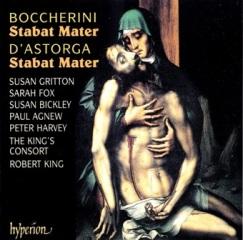Boccherini – Stabat Mater; D'Astorga – Stabat Mater (Robert King) [1999]
Boccherini – Stabat Mater; D'Astorga – Stabat Mater (Robert King) [1999]

Luigi Boccherini (1743-1805): 01. I. Stabat Mater dolorosa 02. II. Cuius animam gementem 03. III. Quae moerebat et dolebat 04. IV. Quis est homo, qui non fleret 05. V. Pro peccatis sua gentis 06. VI. Eia Mater, fons amoris 07. VII. Tui nati vulnerari 08. VIII. Virgo virginum praeclara 09. IX. Fac ut portem Christi mortem 10. X. Fac me plagis vulnerari 11. XI. Quando corpus morietur Emanuele d'Astorga (1680-?1757): 12. I. Stabat Mater dolorosa 13. II. O quam tristis et afflicta 14. III. Quis est homo, qui non fleret 15. IV. Eia Mater, fons amoris 16. V. Sancta Mater, istud agas 17. VI. Fac me tecum pie flere 18. VII. Virgo virginum praeclara 19. VIII. Fac me plagis vulnerari 20. IX. Christe quum sit hinc exire Susan Gritton, soprano Sarah Fox, soprano Susan Bickley, mezzo-soprano Paul Agnew, tenor Peter Harvey, bass The King's Consort Conductor - Robert King
Boccherini wrote very little vocal music; however he left two settings of the Stabat mater. It was first set in 1781 for solo soprano and strings and then in 1800 for two sopranos and tenor, obviously influenced by the hugely-popular Pergolesi Stabat mater of 1736. There are many similarities in the notation and harmony—even the same key of F minor is used. The writing is of extraordinary individuality and seems to come straight from the heart. This unjustly neglected piece is surely one of the most remarkable sacred compostions of the era.
Emanuele d'Astorga was one of the most colourful figures in early eighteenth-century music and his life has often been the subject of legend rather than fact (brief details of which can be discovered in Robert King's illuminating booklet notes). During his life, Astorga was best known for his well-written and tuneful chamber cantatas (of which more than 150 survive) and his opera Dafni (only Act 1 now survives). But by far his most enduring work has proved to be this setting of the Stabat mater, his only surviving sacred composition. Throughout it we hear Astorga's gift for writing warm melodies, typical of the Neapolitan style of the time, and how he captures the melancholy of this most desolate of sacred texts. --- hyperion-records.co.uk
download (mp3 @320 kbs):
uploaded yandex 4shared mega mediafire solidfiles zalivalka cloudmailru oboom








